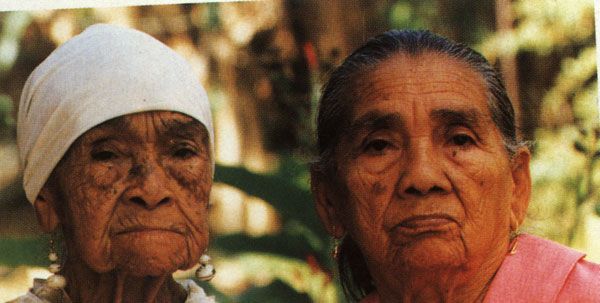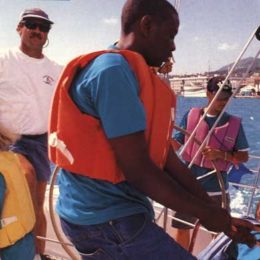The forest-hardened arms of this man gently cradle the head of his granddaughter as they swing in a hammock under an open shed. Kada is two months old. Her tiny eyes and high cheekbones are noticeably his. She carries his future, and the future of the tribe, in her Carib blood.
Christo Glen Adonis, 39, is a descendent of the Karina Pogoto tribe of Caribs. There aren’t many of his people left. Today, Trinidadians are a rainbow mix of faces; “full-blood Caribs” no longer exist. The majority of the descendents of the Carib people live on Calvary Hill, in the eastern borough of Arima (an Amerindian word meaning “place of water”), though you can see traces of Carib genes in the faces of countless others.
The palm-covered shed is like a village community centre where the young meet the old. Some of these meetings are “walk-in” visits, for Adonis is the shaman or medicine man. His Carib name is Atekosang, meaning “The Traveller”. The zemi, a grey stone object, symbolises his shaman status; it is a gift from his friends, the indigenous Taino of Cuba.
Neighbours are greeted with a wave from the hammock; he calls out to a young man, a brother, an aunt. They join him to talk about hunting in the forest; about taking their families to Paria Falls for the weekend. They look to him as a man of authority, a leader, and a chief. They expect a lot, too. His people come searching for various cures; to relieve stress, or alcohol abuse and its attendant woes, or abdominal pain. “They believe I’m a miracle worker,” he says, laughing.
Adonis’s deer horn necklace, called a warun, identifies him as a hunter of manicou (opossum), agouti and lappe (both large rodents), tatoo (armadillo) and quenk (wild hog) — creatures that live in the forests of Trinidad. The forest gives him medicines: he recommends the leaves of the zeb femme plant be boiled and drunk to help produce milk for breast-feeding mothers; for a snake bite, take the tref (a heart-shaped leaf), caterpillar larvae, a scorpion or centipede and a “bachac” snake; soak them in rum, and drink. The forest also gives Adonis his livelihood — he custom-builds indigenous houses; 10 in the last three years. He also fells trees for sawmills and for the Carib Centre to use as firewood to make cassava bread and pastelles in their traditional outdoor oven.
Even though he says it is an eternal struggle, Adonis works hard to invigorate what remains of Carib culture. He performs the sacred smoke ceremony to celebrate birth, to bid the dead farewell, to bless a marriage, at the beginning of a hunting season, for a new crop, or to praise the gods for a bountiful harvest. Adonis jokes: “We have to smoke the men, because you ladies don’t like ‘blight’ men.” The ritual of the smoke ceremony was seen last year as part of a feast put on by the Harmony and Diversity Conference, which was held in Trinidad. Special guests were Chiefs Cibanakan and Wakonax from Puerto Rico, and Chrisarra from the Goorang tribe in Australia.
Ricardo Hernandez-Bharath, 42, a Trinidad citizen originally from El Tigre, Venezuela, represented the Carib people of Trinidad. He is their president and runs the Carib Centre at Paul Mitchell Street, Arima. He and a handful of skilled people make traditional crafts such as shields (using coconut branches); the cibucan (made with terite vine and used to squeeze grated cassava); and graters made from soft wood soaked in water and punched with holes. “Only three of us do this. The elders used to do it, but no longer,” Hernandez-Bharath says.
While there is a sense that some of the old ways are no longer being practised, the tribes still keep in touch across the seas. There are links with First Peoples of St Vincent, Dominica, Grenada, Guyana, Venezuela, Brazil, Colombia and Cuba. When indigenous friends visit, the Carib people of Arima treat them “like a brother who has gone away and fallen in on his return,” Adonis says. They cook, eat and sleep together — like blood brothers. Adonis tells the story of how he and Wakonax were almost thrown out of a Tobago hotel room last year because they were “beating bamboo and singing parang songs with some indigenous words thrown in”.
Out of a black-and-white bag, a boyoco, Adonis takes a loin cloth. In pre-Columbus times, he says, Caribs made their own cloth. On today’s store-bought fabric they paint sacred symbols such as the scorpion, frog and jaguar, which they regard as Mother of the Earth. Also in the bag are a ceremonial marac or chac chac; feathers of the parrot and chicken hawk, and ceremonial beads. The Caribs believe that after death they reincarnate as parrots. They tolerate people who believe their customs are “mumbo-jumbo”, but only just. Adonis lets the uninitiated know the customs and symbols are more than adornment, or an exotic tourist attraction. His role as leader also means protecting his people from ridicule. Like many others, he objected strongly to an advertisement for a beer that portrayed an Indian dancing around a fire and uttering nonsense words. The ad was withdrawn. “I’m very aggressive and emotional where my family, my people, my culture are concerned,” he says. “Politics and religion have destroyed us.”
Some aspects of Carib culture are part of mainstream life in Trinidad. Place names like Caroni, Tunapuna, Tacarigua, Caura and Arouca are derived from the Carib vocabulary. In 1986, the Sixth Annual Biennial Conference, jointly held in Trinidad with the American Dialect Society, revealed that many food staples have an indigenous origin, including arepas, or stuffed cornmeal patties; cassava bread; farin, or cassava flour; barbecue (Caribs called it “buccaneer meat”); coo coo and pastelles, both made with cornmeal; sweet potatoes, plantains and manac, a close relative of the chestnut.
Talk turns to the need for a place to call their home. According to documents written during the time of the Cedula de Population of 1783, 2,000 acres of ancestral land were to have been set aside for the Caribs. Except for the land on which the Carib Centre was built, as a collective they have no land. Formal appeals to successive governments to acquire alternative land, to develop a traditional Amerindian village, have been unsuccessful. If such a village existed, Adonis says, he and his people would reintroduce traditional buildings, and plants such as the gaticare and the timite, which no longer exist. “The men in the Carib community would become game wardens,” says Adonis. “We’d ensure the animals there are preserved. We are knowledgeable about building indigenous structures, like this carat shed,” he says, pointing to the palm-covered shed in which he sits.
And of the future? His son, 16-year-old Kevin, has just finished carving a miniature eagle on a calabash gourd. He’s learning from Adonis who has carved forest birds and animals, the sun and a traditional Carib house on calabash. As Adonis gently rocks the hammock, his granddaughter comfortable in his arms, he talks to Jeremiah Farfan, 24, and Trevis Clarke, 21, who also live on Calvary Hill. He tells them to pass a message on to other young men about a government project that would train them as eco-tourism guides. His aunts-in-law, sisters Mealannie, 91, and June Calderon, 84, and Carib elder Lawrence Augustine, 78, are sitting on a bench. They have listened with pride, or shaken their heads in disapproval, while Adonis has been talking. They are short and small-boned, with sharp cheekbones, eyes small and laughing and set in a sea of a thousand wrinkles. Their steps are certain; their voices strong. They are alert and attentive. And, at times, mischievous: like when they suddenly speak in patois.
“When we are talking people bad, we talk in patois,” Adonis explains. Caught in the act, the sisters grin toothlessly.




















